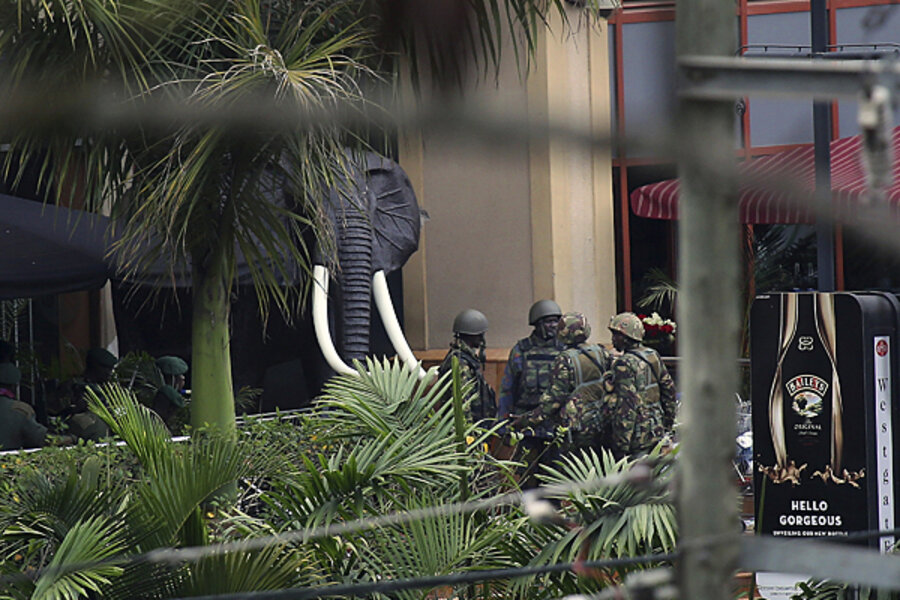Kenya mall attack: Is Al Shabab terror group desperate, or resurgent?
Loading...
A daily summary of global reports on security issues.
A year ago, African security forces thought they had the Islamist terror group Al Shabab on its back foot. They had captured its key strongholds in Somalia and pushed it into the hinterlands. Al Shabab's defeat was portrayed as imminent.
This week's attack on Nairobi's Westgate mall has made it clear that optimism about the group's demise was misplaced. But many analysts argue the siege signals desperation – a final effort to reverse a decline – rather than some form of resurgence..
Ken Menkhaus, a professor at Davidson College in North Carolina and a close observer of the militant group, casts the mall attack as the former.
…Shabaab is weakened. It is still one of the strongest armed groups in south-central Somalia, and still capable of daily assassinations and terrorist attacks in Mogadishu, but it is in a state of serious decline. Over the past two years, it has lost control of almost all urban areas and the lucrative revenues from seaports like Kismayo. Its deep internal divisions exploded in armed conflict this year, resulting in the deaths of several of its top leaders and the splintering of the group. Most foreign mujahedeen have become disillusioned and left Somalia. And, most importantly, far fewer Somalis, both in country and in the large Somali diaspora, actively support the group.
The Westgate attack is the latest sign of the group’s weakness. It was a desperate, high-risk gamble by Shabaab to reverse its prospects.
Mr. Menkhaus dismisses those who argue that the siege was an effort to prove Al Shabab's "relevance" to Al Qaeda, writing that the Somali group's tendency to stage attacks with high civilian casualties has "appalled" the global terror group.
The goal of the attack is to provoke a backlash in Kenya against ethnic Somalis, Menkhaus writes. Somalia and Al Shabab observers have long worried about an attack on a civilian target in Kenya, but the group has held back to avoid upending the economic interests of hundreds of thousands of Somalis who flocked to Kenya, opened up businesses there and made investments. Had an Al Shabab attack provoked a backlash against Somalis in Kenya, a backlash against Al Shabab in Somalia would have likely followed.
But, Menkhaus writes, if Al Shabab's influence deteriorated enough, experts expected it would lash out in the form of a high-risk terror operation abroad – a last ditch effort to provoke a heavy-handed enyan response that could turn Somalis against their host government and send them into Al Shabab's arms.
Clinton Watts, a fellow at George Washington University's Homeland Security Policy Institute, writes at Foreign Policy (subscription required) that Kenyan security forces drove Al Shabab into Somalia's rural interior, but failed to deliver the final blow, allowing the militant group "an operational safe haven" from which it "transitioned from conventional fighting to asymmetric warfare using guerrilla and terror attacks." The goal of this attack is to drum up popular support among disenfranchised Muslims in Kenya and "re-energize" the group, he writes.
Somalis are becoming disillusioned with Kenya's involvement in Somalia and many Kenyans are tiring of the continued military engagement abroad, according to Mr. Watts. The mall attack could cause Kenyans to doubt the utility of the Somalia operation.
Or Al Shabab could be hoping that Kenya responds to the Westgate attack by upping its military involvement in Somalia.
If the attack provokes Kenya to venture deeper into Somalia, al-Shabab hopes it can exhaust foreign forces in an asymmetric campaign of hide-and-seek insurgency. Inciting Kenya's rage and prompting an extended invasion is almost as positive an outcome for al-Shabab as getting the Kenyan military to unilaterally withdraw. Either way, the goal is the same: it's largely a matter of sequencing.
The group has been fracturing since its leader merged Al Shabab with Al Qaeda in 2011, which was followed with a dramatic increase in attacks against civilians. It struggled to attract Western recruits, and began to actively "shun" foreign fighters.
The merger and the uptick in indiscriminate attacks chipped away at the group's popular support and created rifts between leaders.
It's a stretch to say that al-Shabab is reeling, but it's likely ostracized by the al Qaeda core for its very public internal disputes and factionalized by public dissension in the ranks. Needing to distract from killing one of its most celebrated members, a successful and public attack on Nairobi's Westgate Mall resets the agenda and helps Godane silence his critics.
But while it seems strong and dangerous now, the health of al-Shabab is difficult to discern. In July 2010, the group claimed credit for a suicide bombing in Uganda that killed at least 74 people. "We are sending a message to Uganda and Burundi," the group's spokesperson said at the time, adding that if the two countries didn't withdraw their troops from Somalia, "blasts will continue." But follow up attacks never manifested.
The telltale sign of whether this is a last gasp or a resurgence is how quickly additional attacks in Kenya follow, according to Watts.
The sophistication of the attack on Westgate and the presence of many obviously non-Somali combatants has security experts wondering if the group had assistance from other militant groups. “This whole thing seems more advanced than anything the Shabab has ever done,” a Western security official told The New York Times.
“They are clearly a multinational collection from all over the world,” said Julius Karangi, chief of the Kenyan general staff.
Reports that Americans may have participated in the mall attack have raised concerns about Al Shabab's potential reach into US soil, The Christian Science Monitor reports.
Al Shabab recently attracted the attention of the Federal Bureau of Investigations (FBI) for making slickly-produced recruitment videos meant to appeal to Somali-American teenagers in Somali communities throughout the United States.
...
The video’s “production value is very high. That’s new,” FBI Special Agent Kyle Loven, who is based in Minneapolis, told CNN last month. “Obviously, it’s an attempt to step up recruitment efforts.”
But Jennifer Cooke, director of the Africa Program at the Center for Strategic and International Studied (CSIS), argues that the attack did not reflect the level of sophistication exhibited by other terrorist groups, reports the Monitor.
“This was an attack against a pretty defenseless mall on a Sunday afternoon,” she points out.
“The speculation is that Al Shabab leadership wants to make a big, bold show that Shabab is still relevant and still has the capacity for horrific violence,” she adds.
But as horrific as it is, it is not a particularly sophisticated attack requiring “the sort of command and control” seen in other terrorist groups.
That could speak to their ability or inclination to carry out attacks in the United States as well. To date, Al Shabab has had relatively parochial ambitions.
The last major attack the group claimed responsibility for was the 2010 coordinated bombings in Kampala, Uganda, that killed more than 70 people as they gathered to watch a World Cup game.
Similar to this attack, which militants said was retribution for Uganda military incursion into Somalia to fight Al Shabab in 2011, the Uganda attack was reportedly revenge for the Ugandan government's decision to send troops to Somalia, The New York Times reports.
United Nations special representative for Somalia Nicholas Kay said Tuesday that there was a "once-in-a-generation" opportunity to stabilize Somalia and called for additional African troops, Reuters reports. According to him, Al Shabab has about 5,000 members and poses "an international threat."
"Security remains the number one challenge, the control and defeating of al Shabaab is key to this," Kay said at a press conference. "The amount of money that we're talking about that's required for the extra effort in Somalia would be very small. But the cost of walking away would be very expensive."






